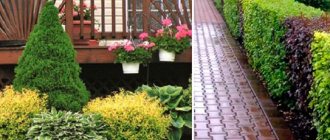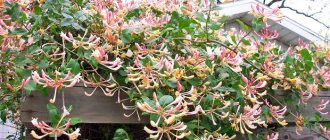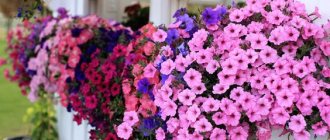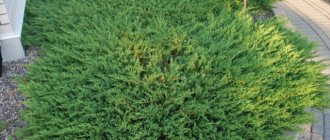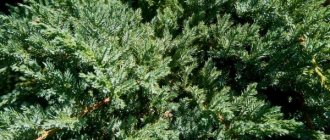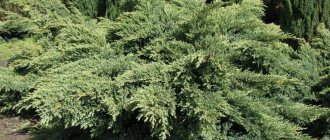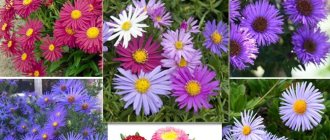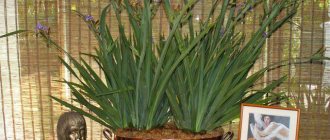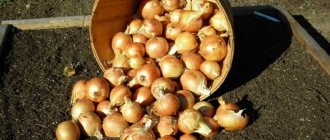Description of the average juniper Pfitzeriana
The middle juniper, or Pfitzeriana (Juniperus Pfitzeriana), is a perennial coniferous plant obtained by crossing the Cossack and Chinese varieties in 1890. The conifer was bred in Germany and received its name in honor of one of the nursery employees, Wilhelm Pfitzer.
The plant has a cushion-shaped crown. Dense shoots of juniper at a young age are directed parallel to the ground, and then stretch upward, although they remain slightly drooping. The branches are slightly flattened, covered with soft needles, needle-shaped closer to the trunk and scaly at the ends. The hue of the average juniper can be green, light green and even golden; some varieties have a bluish color. It bears oval bluish-black cones with a whitish coating, but they are not eaten due to toxicity.
A characteristic feature of Pfitzeriana is the predominantly light shades of the crown.
Frost resistance, drought resistance
Pfitzeriana tolerates frost quite well and can grow in climate zone 5A, where winter temperatures drop to -30 °C. Suitable for breeding both in the southern regions and in the middle zone, in the Moscow region, as well as in the Urals. If there is winter shelter, it can be grown in Western Siberia, but in Eastern Siberia it often freezes out.
The average juniper tolerates drought calmly and can go without watering for a long time. Additional moisture is required only during long hot periods without precipitation.
Growth rate and size of the average juniper
The maximum height of juniper Pfitzeriana is 3 m, but the shrub can spread up to 5 m wide. It adds an average of 10 cm per year, some varieties can grow faster or slower. The pace of development is determined, among other things, by external factors - the ephedra requires a lot of light and prefers loose, aerated soils.
The height of Pfitzeriana rarely rises above 2 m
Characteristics of a Pfitzerian
The average juniper was developed in 1890 in Germany. To create it, two types of plants were crossed: Cossack and Chinese forms. The shrub received its name in honor of the name of the nursery worker - Wilhelm Pfitzerian. The needles are evergreen, very soft. This species combines many varieties. And all of them are characterized by undemanding to growing conditions. However, some nuances still need to be taken into account. For example, it is preferable to plant the crop in the sun. However, juniper also grows well in partial shade. True, colored varieties will lose their brightness. Frost resistance is quite high. Juniper can withstand temperatures down to -30 degrees. If the area is characterized by a colder climate, the plant should be covered for the winter.
Popular varieties of medium juniper
Over the 120 years of the culture’s existence, breeders have developed many varieties of medium-sized juniper. Some of them are especially in demand among gardeners.
Aurea
The average juniper Pfitzeriana Aurea grows up to 1 m in height and 3 m in width by the age of ten. The shoots of the variety are prostrate, bending towards the ground at the ends, the needles are sharp, yellowish-golden in spring and green in summer. It is best to plant the medium juniper Pfitzeriana Aurea in the sun, as it will lose its decorative color in the shade.
Golden shoots of the Aurea variety on clay soils become brighter
Compacta
The slow-growing variety of juniper Pfitzeriana Compacta reaches a maximum height of 1.5 m and spreads over 2 m. The needles of the variety are grayish-green, the shoots are horizontal, but slightly raised upward. Unlike most varieties, the average juniper Pfitzeriana Compacta does not suffer from a lack of full sun.
The Compact variety can be planted both in the sun and in the shade without compromising its decorative properties.
King of Spring
The dwarf medium juniper King of Spring rises no higher than 50 cm, although it can grow up to 2 m wide. The variety's needles are juicy and yellowish in color, but the color is retained only in bright light; in the shade the shrub becomes simply green.
King of Spring is often used in the design of slopes and lawns.
Blue and Gold
The average juniper Blue and Gold has a very unusual coloring, its needles are mostly bluish-green, but the tips of the shoots are creamy yellow. It can reach 2 m in diameter, but it rises above the ground to a maximum of 1.5 m, develops slowly and adds several centimeters per year. The photo of Blue and Gold juniper shows that the shape of the shrub is asymmetrical, spreading, with shoots directed upward.
Juniper Blue and Gold loves illuminated areas
Glauka
The beautiful medium-sized juniper Pfitzeriana Glauca (Glauca) has a dense bluish crown. In adulthood, it rises up to 2 m above the ground, the shoots are spread out and directed upward, slightly hanging at the tips. The variety is highly unpretentious, grows well in poor soils, prefers bright sunny places.
Glauka can spread 4 m wide
Gold Coast
The average Gold Coast juniper can grow up to 1.5m above the ground. The crown of the plant is very bright, golden-green, the shoots are raised above the ground, but hang down at the ends. The shape of the average Gold Coast juniper is spreading, uneven, and can reach 2 m in width.
Gold Coast maintains the brightest color possible in illuminated areas
Mordigan Gold
Juniper Pfitzeriana Mordigan Gold is a compact variety and rarely grows more than 1 m. The branches of the conifer are horizontal, dense, drooping towards the ground at the tips. The color of the plant is yellowish, but it remains only in the sun; if you plant juniper in dense shade, it will turn rich green.
Mordigan Gold can grow up to 2 m in diameter
Dubs Frosted
The low-growing, prostrate juniper Doubs Frosted rises no higher than 35 cm by the age of ten. It is used primarily to form soil cover. The young needles of the plant are golden-yellow in color; as the bush matures, it acquires a blue-green color.
Juniper Dubs Frosted reaches 1.5 m wide
Blonde
The medium-sized juniper Pfitzeriana Blond rises above the ground up to 1 m and grows sideways up to 3 m. The shrub is spreading, with horizontally elongated shoots and hanging tips. In spring and summer it pleases with the golden-yellow hue of the needles, and by winter it darkens and becomes reddish.
Medium juniper Blond can grow on any soil - alkaline, acidic, dry and rocky.
Methot
The average juniper Methot can rise up to 80 cm and spread 1.5 m. The crown is uneven, with shoots growing to the sides, the shade of the needles is bright green, with a slight yellowness.
Methot is a light-loving variety that loses its brightness in shade
Saybrook Gold
The elegant medium-sized juniper Saybrook Gold grows to the sides by 3 m and rises above the ground to 1.2 m. The shoots are directed upward at an angle, densely covered with needles, yellowish when young and rich green when mature.
Saybrook Gold grows slowly and by the age of 10 reaches only 50 cm
Wilhelm Pfitzer
The average juniper Wilhelm Pfitzer is distinguished by the bright green color of its needles with almost no yellowness. It usually adds 10 cm per year, and can grow up to a maximum of 3 m in height and up to 5 m in diameter.
Wilhelm Pfitzer is considered a tall variety, but grows slowly
Old Gold
Medium juniper Old Gold is a compact shrub with scaly needles. Throughout the year it retains a warm bronze-yellow shade of the crown, rising to 1.5 m after 10 years.
Old Gold maintains the same shade throughout the year
Carbury Gold
The spectacular medium juniper Carbery Gold grows on average 1 m. The shade of the crown of the conifer is pleasant golden, the shoots are horizontal and slightly raised, drooping at the tips. Like most varieties, Carbery Gold prefers sunny places, as it loses its decorative effect in the shade.
Carbury Gold, with its short stature, reaches a width of up to 2 m
Gold Kissen
Juniper Gold Kissen is a medium-sized variety and rises above the ground by 50 cm in 10 years. The crown is asymmetrical with long drooping branches, the needles are light green, yellow at the tips.
Gold Kissen can spread shoots up to 2 m
Gold Star
The beautiful, medium-sized Gold Star juniper is slightly star-shaped and grows up to 1.5 m in height. In illuminated areas it retains the bright golden hue of the crown.
Gold Star can reach up to 1.5 m in width, but remains compact
Hetzi
The average juniper Hetzii is considered tall and can rise up to 2.8 cm above the ground. The crown of the plant is irregular in shape, with soft gray-green needles.
Hetzi under favorable conditions grows up to 4 m in diameter
Mint Julep
The Mint Julep variety is distinguished by its bright green crown color. The shoots are arched, long and hanging. The height of the average Mint Julep juniper at maturity is 2 m.
Mint Julep exudes a pleasant minty scent
Peculiarities
The evergreen coniferous shrub juniper medium pfitzeriana compacta grows slowly, by the age of ten it does not reach the meter mark, although the diameter of the bush will be impressive - about one and a half meters or more. A wide, dense crown, horizontal branches, light green needles and small cones make it an unusually beautiful and original plant.
In addition to its beautiful appearance, juniper has medicinal properties. Its pleasant, light aroma is an excellent means of preventing and treating neuroses, respiratory diseases, strengthening the immune system and improving the general condition of the body.
Every year, Russian landscape designers increasingly use juniper medium pfitzeriana compacta in their compositions. It performs the functions of green areas, organically fitting into the urban landscape and focusing on bright colors and halftones. Unlike European ones, domestic gardeners and landscape designers are just beginning to discover it for themselves and use it to bring their bold plans and projects to life. If just a few years ago pfitzeriana was exotic for Russia, now the demand for the plant is growing and it can increasingly be found on sale.
Note to newbies! When starting to work with pfitzeriana, remember the means of protection, since all types and varieties of juniper without exception are poisonous plants. Toxic substances contained in needles, cones and other parts of the plant pose a particular danger to children and pets. Tell your children about this, they should know that playing with juniper is dangerous!
The use of juniper Pfitzeriana in landscape design
Medium juniper is a versatile conifer with a very wide range of design uses. In particular, shrubs are used:
- as part of alpine slides, flower beds, flower beds and rose gardens;
Pfitzeriana looks organically in low compositions
- for decorating coastlines;
Medium juniper looks organic near water
- for creating borders and mixborders;
Bright medium juniper looks impressive in borders along paths
- in group compositions;
Pfitzeriana goes well with other conifers
- in rockeries.
Medium juniper grows well among stones
Coniferous plants are often planted on vacant lawns and vacant lots to enliven the space.
General information about culture
Juniper Pfitzeriana was born in 1890. In Germany, Wilhelm Pfitzerian crossed two species - Cossack and Chinese, as a result of which this new shrub arose.
The tree is a coniferous species. It has lush arched branches that are covered with soft needle-like needles with scales. The height of the plant reaches 1.5 m, and the width - 3 m. Pfitzeriana will delight others with its wonderful green color all year round.
This juniper includes several different species that have their own characteristics, although according to the description they are very similar to each other.
The most popular among them are:
Juniper Pfitzeriana Glauck is distinguished by its gray-green or silvery hue. It can reach 4 m in width. The crown itself is very branched. The main advantage of this species is that any soil is suitable for it, and it easily tolerates heat.
No less interesting is the medium juniper Pfitzeriana Aurea, which is a fast-growing plant. In a year, a tree can grow by 20 cm. In general, its height reaches 3.5 m, and its width sometimes reaches 5 m. A distinctive feature of the species is the ability to change color. The summer green color in winter gives way to a yellow-green tint. It is worth noting its resistance to frost and spring burns.
Important! Juniper Pfitzeriana Aurea does not require regular pruning. Only dried branches need to be cut off.
The next no less popular type is Gold Coast. Unlike juniper Pfitzeriana Glauca, as well as other representatives of this species, it is a low-growing shrub. Its height barely reaches one meter. In addition, Gold Coast grows very slowly. Its distinctive feature is its golden-green-yellow color.
And finally, juniper Compacta. The height of this shrub barely reaches 80 cm and the width is 2 m, which is why it is considered a compact plant. The tree looks great on terraces and rocky slopes. The shrub has a gray-green hue. In addition, this species tolerates shade well and is not fussy about the soil.
Reproduction methods
There are three ways to get a new medium-sized juniper on your site:
- seeds;
- cuttings;
- layering.
Typically, cuttings of young shoots are used for propagation; they form roots in about 2 months.
Pfitzeriana cuttings germinate quickly and without difficulty. Attention! Seed propagation takes a long time and is not suitable for hybrid varieties, and layering is convenient to root only in dwarf plants.
Propagation of juniper pfitzer
Pfitzeriana, like other varieties, is successfully propagated using cuttings.
- As planting material, young spring shoots about 12 cm long are cut from the bush and cleared of needles from both ends.
- For a couple of months, the cuttings are placed in a mini-greenhouse - a small box with a substrate suitable for juniper.
- The top of such a box is covered with plastic film to create a suitable temperature and humidity, but the film needs to be opened briefly every day.
Rooting occurs in approximately 2 months. After this, the young seedlings, together with the existing substrate, are transplanted into larger boxes and grown indoors for another 1-2 years, after which they are planted in open ground.
Landing Features
It is recommended to transfer the medium juniper Pfitzeriana into the ground in early spring after the snow cover melts or in October, about a month before the onset of cold weather. Choose a place that is well lit and without strong drafts; the conifer needs loose and well-ventilated soil, close to neutral:
- A month before planting, a hole is prepared for Pfitzeriana, 2-3 times the size of the roots.
- A drainage layer of broken bricks or pebbles is poured onto the bottom, then the hole is half filled with a soil mixture of sand, peat, coniferous soil and turf.
- The seedling chosen is healthy, with strong roots, and no older than 3 years old. Shoots and needles must be free of signs of disease and damage. On the day of planting, the average juniper needs to be watered generously or soaked in water with the root system exposed.
Planting a conifer looks like this: the seedling is lowered into the hole and completely covered with the remains of the soil mixture. The root collar is left 15 cm above ground level, the plant is immediately watered and mulched with sawdust or bark.
The hole for a medium juniper needs to be prepared a month before planting
Advice! To strengthen the endurance of Pfitzeriana, before planting, you can keep its roots in a weak solution of potassium permanganate.
Planting and care in the garden
They start planting juniper in April - early May. But, if the purchased seedlings are in pots, they can be planted throughout the warm season.
If the purchased seedlings are in pots, they can be planted throughout the warm season.
A place for juniper is chosen that is open to the sun or in the lacy shade of large trees. Shrubs should not be placed in lowlands, places where spring melt moisture may linger. The ephedra dies if the root system is waterlogged for a long time.
The perennial does not have any special requirements for soil. The soil must be loose and breathable. Sandy loams and loams are well suited, to which peat or sand is added, bringing the soil into compliance with the following parameters:
- peat - 1 part;
- turf humus - 2 parts;
- coarse river sand or SGS (sand-gravel mixture) - 1 part.
The distance between the bushes is maintained at least 3 m, keeping in mind the spreading nature of the crown growth. While the juniper is small, the free space is filled with annuals.
A place for juniper is chosen that is open to the sun or in the lacy shade of large trees.
Boarding order.
- For the seedling, dig a hole twice the size of the pot in which the juniper sits. Drainage is poured onto the bottom: broken brick or gravel. The drainage layer is 15–20 cm.
- The soil removed from the pit is brought to the desired state by adding sand or peat. Apply complex mineral fertilizer for coniferous plants (Buiskoe, Pokon, Fertika) in the recommended dosage.
- The seedling is taken out of the pot without destroying the earthen ball. It is planted without filling the root collar with soil. The soil around the trunk is compacted with palms, then watered.
It is recommended to mulch the seedlings with peat, tree bark, and decorative colored pebbles (after covering the soil with agro-fabric). Mulch helps retain moisture in the soil, saves roots from overheating, and suppresses the growth of weeds.
Some gardeners practice grassing: sowing lawn grass around perennials. The grass is regularly mowed, watered and fed.
Care
Newly planted juniper medium Pfitzeriana Glauc must be watered regularly and protected from the scorching rays of the sun. After a month or a month and a half, the frequency of watering is reduced and the sun cover is removed.
Newly planted juniper must be watered regularly and protected from the scorching rays of the sun.
With the onset of the first frosts, young plants are mulched with sawdust to a height of 20–25 cm, and covered with spruce branches on top. Adult junipers do not need shelter. Due to the horizontal growth and flexibility of the branches, the conifers are not afraid of heavy snowfalls, the branches do not break.
An adult plant requires virtually no care. Juniper is watered only in severe drought, preferring sprinkling to root watering. The perennial does not like excessively dry air.
The perennial does not like excessively dry air.
Once a year, in the spring, the plantings are fed with complex mineral fertilizer. The finished composition for coniferous plants is scattered on the surface of the soil around the plants. It is useful to spray the crown with microelements to enhance the brightness of the color.
To obtain a denser and denser crown, formative pruning of young shoots is carried out in the spring. Damaged or old branches are also cut out.
Diseases and pests
Juniper can suffer from fungal diseases and viruses. Plants suffer in damp and cool summers, when it is easier for fungal spores to reproduce. Pockets of red needles appear on the bush, the needles dry out and fall off. A grayish cotton-like coating may appear on the bark.
The following drugs are used as treatment: Rakurs, Strobi, HOM, Abiga Peak. Spray the crown of the conifer in calm weather several times a season. If the summer is expected to be humid, it is recommended to carry out preventive spraying with these preparations.
Plants suffer in damp and cool summers, when it is easier for fungal spores to reproduce.
Juniper is plagued by spider mites, aphids, scale insects, and sawflies. Insects are gotten rid of using insecticides: Iskra, Aktellik, Aktara.
Aftercare
When growing Pfitzeriana, you need to pay attention to just a few points. Ephedra develops well provided proper watering and winter insulation.
Watering and fertilizing schedule
After planting in the ground, the average juniper needs to be watered every week. But mature plants usually have enough natural precipitation; they should be moistened only during particularly hot summer periods. Irrigation of the crown will be useful; it will help maintain bright color.
Conifers are fed once a year, in April or early May. Nitrogenous fertilizers are added to the soil to accelerate the growth of shoots. But you cannot water the bush with manure and bird droppings, since the organic matter will burn its roots.
Pruning rules
Every year, Pfitzeriana is given a sanitary pruning and all diseased and broken branches are removed. This is done in early spring, before the bush begins to actively grow.
Since Pfitzeriana grows slowly, the shrub needs to be formed every few years.
Decorative pruning is rarely required for the crop. It is carried out as necessary, when the shoots grow too much and the plant loses its neat appearance.
Mulching, loosening the soil
To make water evaporate more slowly, the average juniper is mulched with pine needles, mowed grass or peat. The procedure not only helps keep the soil moist, but also slows down the growth of weeds.
Once every 3-4 weeks, it is recommended to loosen the soil to improve oxygen access and for preventive pest control. This must be done carefully so as not to damage the surface roots of Pfitzeriana.
Preparing for winter
In early October, the bush can be watered abundantly, provided that the autumn was warm and dry. The conifer should winter in moist soil, then its roots will not freeze. For additional insulation, the area is mulched with a 10 cm layer of peat; organic matter also acts as a fertilizer.
For the winter, the average juniper is protected entirely from frost and heavy snow.
It is recommended to cover Pfitzeriana from frost with burlap or lutrasil so that the shoots do not freeze and break under the snow. In adult plants, branches can be tied or bent to the ground, and then carefully wrapped.
Planting and care
Medium juniper comes from mountainous regions.
He was accustomed to the poor siliceous soil. Plant the bush in loose and fertile soil with a neutral pH for the growth of a lush crown. But when growing on poor soil, the colors of the needles are more saturated in tone.
Juniper is frost-resistant and does not withstand cold whirlwinds. Light-loving, plant it in sunny places or in partial shade. If planted in the shade, the plant grows small, elongated, with loose foliage. The exception is young, recently transplanted bushes. When the sun is intense and strong, they are shaded. This applies to the variety Pfitzeriana Gold Star
When planting a bush, pay attention to the water supply. If there is no area with a good supply of water, then drainage work is carried out first
Juniper does not like dry soil, so it is possible to water it.
Mulching with leaves or sawdust will help solve this problem. It is produced immediately after disembarkation. In the future, mulch only if the bushes are not surrounded by trees or lawn. During drought or hot weather, the bush is watered and sprinkling is applied to the crown.
Use in landscape design
The bush is used because of its variety of shapes and decorative properties.
It looks good with groups of fir, spruce and pine trees. With his participation, ensembles with flowering shrubs are organized: with spirea and bladderwort. The plant is unpretentious and can withstand the conditions of large cities. It has an invaluable property - it lives for a long time. If you plant bushes with different needles, then a rainbow and evergreen landscape with a pine scent is guaranteed for a hundred years.
Juniper Pfitzeriana is the most popular bush in landscape design. It represents possible decorative types and forms. Popular: Aurea, Glauka, Old Gold, Compacta, Mordigan Gold. All varieties are used in landscaping, organizing the design of house walls, flint hills, and decorating terraces.
Description
Evergreen wide-spreading shrub. The branches are located at an angle. The needles are needle-shaped and scale-like, bluish-blue in full sun to gray-green in partial shade, with a slight purple tinge in winter. The growth rate is moderate, reaching 2-3 m in height and 3-4 m in width. It is undemanding to soils, grows on all types of soils, from dry to wet, acidic and alkaline. A very frost-resistant and drought-resistant variety, resistant to urban climate and harmful emissions, easy to cut. Recommended for single and group plantings against a lawn, rock gardens, rocky areas, landscaping balconies and roofs, growing in containers, for parks and large gardens.
Pests and diseases of juniper Pfitzeriana
The shrub especially often suffers from the following ailments:
- brown shutte;
The needles with a brown chute darken, but do not fall off for a long time
- rust;
When rust occurs, recognizable orange growths appear on the shoots and needles
- Fusarium
Fusarium wilt is especially dangerous for the average juniper because it affects its roots.
The fight against fungal diseases is carried out with the drug Fundazol and Bordeaux mixture. Treatment should begin at the first symptoms, and all affected shoots should be eliminated.
Among the pests that are dangerous to coniferous plants are:
- aphid;
Small aphids can seriously eat juniper needles
- sawfly;
Black-green sawfly caterpillars actively feed on shoots and needles
- juniper scale insect.
The scale insect eats juniper needles and causes great damage
Well-known insecticides help against pests - Aktellik, Aktara, Karbofos. It is very important to carry out prevention, loosen the soil in a timely manner and thoroughly remove debris from the area with the onset of autumn.
Common diseases and pests
If you strictly follow all the recommendations, the tree will grow healthy. But there are still cases when it succumbs to certain diseases. Most often, this shrub suffers from diseases such as:
Schutte brown is a very dangerous disease. The word schutten comes from the German language and translated means to crumble. And this is true; the needles of affected plants first turn yellow, die, and then fall off. The fact that the plant is sick is indicated by the brown-brown tint of the leaves, which appears on them at the beginning of summer, and after some time black dots form.
Weak shrubs, as well as those growing in excessively wet soil or in the shade, are susceptible to this disease.
To overcome brown shutte, you need to cut off all damaged branches, remove foliage and treat the bush with a product such as Quadris or Strobi.
The next no less dangerous disease is rust. Its causative agent is basidiomycetes. The affected plant is distinguished by a swollen stem, on which bright orange growths form over time. Rust is dangerous not only because it spoils the aesthetic appearance of the shrub, but can also lead to its death.
Important! If the branches are affected by rust, then they already need to be pruned, since they cannot be treated. Secateurs must be disinfected so as not to spread spores
The remaining areas of the bush are treated with fungicides.
Rust is easier to prevent than to treat. Therefore, to be on the safe side, it is necessary to treat the plant several times with Vectrom or Bayleton.
Drying of branches can also lead to the death of shrubs, the causative agent of which is a variety of pathogenic fungi. The cause of this disease is dense planting and heavy soil. The affected branches are cut off, and the bush is treated with fungicides, such as Skor and Tilt.
As for pests, juniper scale insects and moths, as well as aphids and mealybugs, like to feast on the bush. Actellik, Enzhio, Caesar and Aktara have proven themselves well in the fight against these parasites.
If you need to diversify the landscape near your house, or the task is to decorate an entire park, then you should definitely pay attention to the Pfitzerian juniper. It looks good against the backdrop of pines, firs and spruces
Of course, juniper, together with flowering shrubs, will change the landscape design simply beyond recognition.
https://letnyayadacha.ru/sad/kustarniki/hvojnye/mozhzhevelnik/vidy-mozh/kakimi-sortami-predstavlen-mozhzhevelnik-pfittseriana-pfitzeriana.htmlhttps://fermer.blog/bok/hvoynye-derevya/mozhzhevelnik/vidy- mozhzhevelnika/mozhzhevelnik-sredniy/15316-mozhzhevelnik-pfitceriana.htmlhttps://7ogorod.ru/prochee/mozzevelnik-pfitceriana.html
How to plant a plant
The plant is propagated by cuttings and layering. It is best to use spring shoots about 12 cm long as cuttings. But the best take root is layering that is taken from April to July.
In order for the juniper medium Pfitzeriana to take root and fully develop, you must adhere to the planting rules:
- Plant the shrub in a sunny area.
- The distance between bushes should not be less than half a meter, it all depends on the type of juniper.
- It is necessary that the size of the planting pit is 3 times larger than the earthen ball.
- The bottom of the pit is sprinkled with sand and broken bricks. The thickness of such a drainage layer should be about 20 cm.
- The pit itself is filled with a mixture of peat, sand and turf soil in a ratio of 2:1:1.
- A growth stimulant is also added during planting. In this case, Kornevin proved himself to be excellent. For 1 tree you should use 2-2.5 liters of this product.
- After planting, the shrub is watered abundantly for a week.
Description of the variety
Juniper medium Pfitzeriana Compacta was obtained in Germany from crossing two types of conifers: Kazatsky and Chinese junipers. As a result of selection, a compact plant was obtained that fits perfectly into the design of a small area.
By the age of 10 years, juniper reaches a height of 1 m, the diameter of the bush is 2 m. The perennial belongs to the slowly growing conifers, stretching in height by 8-10 cm per year.
The crown of the plant resembles a lush flat pillow, without a pronounced top. The branches extend horizontally from the trunk, their tips rising upward.
The needles of juniper Pfitzeriana are green, with a gray (silver) coating. At the base of the shoots the needles are needle-shaped, then they are scaly, small, and prickly.
The perennial has a developed root system, thanks to which the shrub tolerates drought well. The variety is frost-resistant and shade-tolerant, suitable for growing in urban areas.
This variety is recommended to be placed in rock gardens and rockeries, in the company of vertically growing conifers (thuja, spruce) and perennial plants (hosta, barberry, astilbe, daylily).
